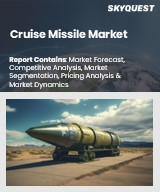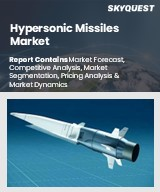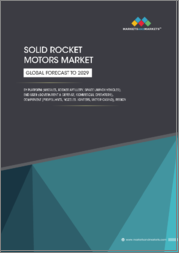
|
시장보고서
상품코드
1847142
순항 미사일 시장 규모, 점유율, 성장 분석 : 미사일 유형별, 구성요소별, 미사일 속도별, 발사 플랫폼별, 미사일 사정거리별, 유도 기술별, 지역별 - 산업 예측(2025-2032년)Cruise Missile Market Size, Share, and Growth Analysis, By Missile Type, By Component, By Missile Speed, By Launch Platform, By Missile Range, By Guidance Technologies, By Region - Industry Forecast 2025-2032 |
||||||
세계의 순항 미사일 시장 규모는 2023년에 29억 달러로 평가되었으며, 2024년 31억 4,000만 달러에서 2032년에는 58억 9,000만 달러로 성장할 것으로 예상되며, 예측 기간(2025-2032년) 동안 CAGR은 8.2%로 성장할 전망입니다.
세계 순항 미사일 시장은 국방 예산의 증가와 현대화 프로그램, 특히 장거리 정밀 타격 능력에 대한 강력한 집중에 힘입어 체계적으로 성장하고 있습니다. 지정학적 긴장과 국경 분쟁은 즉각적인 억제력으로서 정교한 미사일 시스템에 대한 수요를 증가시키고 있습니다. 시장에서는 정밀 표적, 스텔스 기능, 멀티 플랫폼 상호 운용성에 대한 중요성이 점점 더 강조되고 있으며, 국방 기관은 차세대 순항 미사일 개발에 많은 자원을 투입해야 합니다. 유도 시스템, 하이브리드 및 가스 터빈 추진, 실시간 데이터 처리의 혁신은 이러한 미사일의 정확도와 작전 범위를 크게 향상시켰습니다. 또한, 민간 제조업체와 방산 기관과의 협업은 기술 혁신을 촉진하고 순항 미사일 분야의 확장을 더욱 촉진하고 있습니다.
세계 순항 미사일 시장 촉진요인
세계 각국은 종합적인 국방 현대화 구상에 따라 첨단 순항 미사일 시스템 개발에 많은 자원을 투입하고 있습니다. 미국, 러시아, 중국, 인도 등 주요 국가들은 장거리 공격 능력 강화, 멀티 플랫폼 기능 통합, 고도화된 적대적 시스템에 대한 방어력 향상에 주력하고 있습니다. 이러한 군사력 강화에 대한 노력으로 최신 순항 미사일 기술에 대한 수요가 지속적으로 증가하고 있습니다. 각국이 이러한 발전을 우선시함에 따라 세계 순항 미사일 시장은 강력한 성장을 보이고 있습니다. 이는 점점 더 복잡해지는 세계 정세 속에서 국가 안보와 기술적 우위를 확보하는 데 전략적으로 초점을 맞추고 있음을 반영합니다.
세계 순항 미사일 시장 억제요인
순항 미사일, 특히 차세대 극초음속 미사일 개발은 연구개발비가 많이 들어가기 때문에 재정적으로 큰 어려움이 있습니다. 이러한 첨단 무기는 고급 재료의 사용이 필요하고 전문 테스트 시설이 필요하기 때문에 단가가 상승하게 됩니다. 그 결과, 특히 신흥 경제국에서 전략적 억지력과 군비통제 협정 준수의 균형을 맞추는 경우, 소규모 국방 예산으로는 이러한 고가의 시스템을 조달하는 데 어려움을 겪는 경우가 많습니다. 이러한 재정적 장벽은 이들 국가가 효과적으로 국방력을 강화하고, 경쟁적인 세계 정세 속에서 첨단 군사 기술을 채택하는 능력을 제한할 수 있습니다.
세계 순항 미사일 시장 동향
세계 순항 미사일 시장은 마하 5 이상의 속도로 이동하도록 설계된 극초음속 미사일 개발로 크게 이동하고 있습니다. 이러한 전환의 배경에는 스크램제트, 하이브리드 시스템 등 사거리, 응답시간, 고도화된 방공 시스템을 돌파하기 위한 첨단 추진기술에 대한 방위기관 및 제조업체의 투자가 증가하고 있는 것이 있습니다. 또한, 극초음속 성능에 대한 강조는 열 보호, 스텔스 코팅, 적응형 비행 알고리즘과 같은 중요한 분야에 대한 연구를 촉진하고 있습니다. 그 결과, 이러한 발전은 현대전의 새로운 위협에 대한 순항 미사일의 생존성과 치사율을 향상시킬 수 있는 태세를 갖추고 있습니다.
자주 묻는 질문
목차
소개
- 조사 목적
- 조사 범위
- 정의
조사 방법
- 정보 조달
- 2차와 1차 데이터 방법
- 시장 규모 예측
- 시장 가정과 제한
주요 요약
- 세계 시장 전망
- 공급과 수요 동향 분석
- 부문별 기회 분석
시장 역학과 전망
- 시장 개요
- 시장 규모
- 시장 역학
- 성장 촉진요인과 기회
- 성장 억제요인과 과제
- Porters 분석
주요 시장 인사이트
- 핵심성공요인
- 경쟁 정도
- 주요 투자 기회
- 시장 생태계
- 시장 매력 지수(2024년)
- PESTEL 분석
- 거시경제 지표
- 밸류체인 분석
- 가격 분석
순항 미사일 시장 규모 : 미사일 종류별 & CAGR(2025-2032년)
- 시장 개요
- 대지 공격 순항 미사일(LACM)
- 대함 순항 미사일(ASCM)
- 공중 발사 순항 미사일(ALCM)
순항 미사일 시장 규모 : 구성요소별 & CAGR(2025-2032년)
- 시장 개요
- 유도 시스템
- 추진 시스템
- 탄두
- 미사일 기체
- 센서와 시커
- 통신 시스템
순항 미사일 시장 규모 : 미사일 속도별 & CAGR(2025-2032년)
- 시장 개요
- 아음속(마하 1이하)
- 초음속(마하 1-5)
- 극초음속(마하 5 이상)
순항 미사일 시장 규모 : 발사 플랫폼별 & CAGR(2025-2032년)
- 시장 개요
- 공정
- 지상 발사형
- 해군
순항 미사일 시장 규모 : 미사일 사정거리별 & CAGR(2025-2032년)
- 시장 개요
- 단거리(1000 km 미만)
- 중거리(1000-3000 km)
- 장거리(3000 km 이상)
순항 미사일 시장 규모 : 유도 기술별 & CAGR(2025-2032년)
- 시장 개요
- 자율형
- 실시간 추적
- 군지능
순항 미사일 시장 규모 : 동작 모드별 & CAGR(2025-2032년)
- 시장 개요
- 사전에 프로그램된 타겟
- 다이나믹 타겟팅/비행 중 리타겟팅
- 배회/순회
순항 미사일 시장 규모 & CAGR(2025-2032년)
- 북미
- 미국
- 캐나다
- 유럽
- 독일
- 스페인
- 프랑스
- 영국
- 이탈리아
- 기타 유럽
- 아시아태평양
- 중국
- 인도
- 일본
- 한국
- 기타 아시아태평양
- 라틴아메리카
- 브라질
- 기타 라틴아메리카
- 중동 및 아프리카
- GCC 국가
- 남아프리카공화국
- 기타 중동 및 아프리카
경쟁 정보
- 상위 5개사의 비교
- 주요 기업의 시장 포지셔닝(2024년)
- 주요 시장 기업이 채용한 전략
- 최근의 시장 동향
- 기업의 시장 점유율 분석(2024년)
- 주요 기업 개요
- 기업 상세
- 제품 포트폴리오 분석
- 기업 부문별 점유율 분석
- 매출 전년비 비교(2022-2024년)
주요 기업 개요
- Lockheed Martin Corporation(US)
- RTX Corporation(US)
- MBDA(France)
- The Boeing Company(US)
- Northrop Grumman(US)
- Tactical Missiles Corporation(Russia)
- BrahMos Aerospace(India)
- Kongsberg Defence & Aerospace(Norway)
- General Dynamics(US)
- BAE Systems(UK)
- Thales Group(France)
- Israel Aerospace Industries(IAI)(Israel)
- Rafael Advanced Defense Systems(Israel)
- China Aerospace Science and Technology Corporation(CASC)(China)
- Defense Research and Development Organisation(DRDO)(India)
- Leonardo S.p.A.(Italy)
- Saab AB(Sweden)
- L3Harris Technologies(US)
- Roketsan(Turkey)
- Avibras Industria Aeroespacial S/A(Brazil)
결론과 제안
KSM 25.10.28Global Cruise Missile Market size was valued at USD 2.9 billion in 2023 and is poised to grow from USD 3.14 billion in 2024 to USD 5.89 billion by 2032, growing at a CAGR of 8.2% during the forecast period (2025-2032).
The global cruise missile market is experiencing systematic growth, propelled by rising defense budgets and a strong focus on modernization programs, particularly in long-range precision strike capabilities. Geopolitical tensions and border disputes have intensified the demand for sophisticated missile systems as immediate deterrents. The market is increasingly emphasizing precision targeting, stealth features, and multi-platform interoperability, prompting defense agencies to allocate significant resources to next-generation cruise missile development. Innovations in guidance systems, hybrid and gas turbine propulsion, and real-time data processing have vastly improved the accuracy and operational range of these missiles. Moreover, collaborations between private manufacturers and defense organizations foster innovation, further driving expansion in the cruise missile sector, thus establishing a robust landscape for future advancements.
Top-down and bottom-up approaches were used to estimate and validate the size of the Global Cruise Missile market and to estimate the size of various other dependent submarkets. The research methodology used to estimate the market size includes the following details: The key players in the market were identified through secondary research, and their market shares in the respective regions were determined through primary and secondary research. This entire procedure includes the study of the annual and financial reports of the top market players and extensive interviews for key insights from industry leaders such as CEOs, VPs, directors, and marketing executives. All percentage shares split, and breakdowns were determined using secondary sources and verified through Primary sources. All possible parameters that affect the markets covered in this research study have been accounted for, viewed in extensive detail, verified through primary research, and analyzed to get the final quantitative and qualitative data.
Global Cruise Missile Market Segments Analysis
Global Cruise Missile Market is segmented by Missile Type, Component, Missile Speed, Launch Platform, Missile Range, Guidance Technologies, Operational Mode and region. Based on Missile Type, the market is segmented into Land-Attack Cruise Missiles (LACM), Anti-Ship Cruise Missiles (ASCM) and Air-Launched Cruise Missiles (ALCM). Based on Component, the market is segmented into Guidance Systems, Propulsion Systems, Warheads, Missile Airframe, Sensors & Seekers and Communication Systems. Based on Missile Speed, the market is segmented into Subsonic (Below Mach 1), Supersonic (Mach 1 - 5) and Hypersonic (Above Mach 5). Based on Launch Platform, the market is segmented into Airborne, Ground-Launched and Naval. Based on Missile Range, the market is segmented into Short Range (Below 1000 km), Medium range (1000-3000 km) and Long Range (Above 3000 km). Based on Guidance Technologies, the market is segmented into Autonomous, Real-Time Tracking and Swarm Intelligence. Based on Operational Mode, the market is segmented into Pre-Programmed Targets, Dynamic Targeting/In-Flight Retargeting and Loitering /Patrolling. Based on region, the market is segmented into North America, Europe, Asia Pacific, Latin America and Middle East & Africa.
Driver of the Global Cruise Missile Market
Countries worldwide are significantly channeling resources into the development of advanced cruise missile systems, aligning with their comprehensive defense modernization initiatives. Major nations like the United States, Russia, China, and India are focusing on enhancing long-range strike capabilities, integrating multi-platform functionality, and improving defenses against advanced adversarial systems. This commitment to bolstering military capabilities is driving a consistent demand for contemporary cruise missile technologies. As nations prioritize these advancements, the global cruise missile market is witnessing robust growth, reflecting a strategic emphasis on ensuring national security and technological superiority in an increasingly complex global landscape.
Restraints in the Global Cruise Missile Market
The development of cruise missiles, especially next-generation hypersonic variations, presents significant financial challenges due to high research and development expenses. These advanced weapons necessitate the use of sophisticated materials and require specialized testing facilities, contributing to elevated unit costs. Consequently, smaller defense budgets often struggle to accommodate the procurement of such costly systems, particularly when balancing strategic deterrence needs with compliance to arms control agreements, especially in emerging economies. This financial barrier can limit the ability of these nations to enhance their defense capabilities effectively and adopt advanced military technologies in a competitive global landscape.
Market Trends of the Global Cruise Missile Market
The Global Cruise Missile market is experiencing a significant shift towards the development of hypersonic missiles, which are designed to travel at speeds greater than Mach 5. This transition is driven by increasing investments from defense agencies and manufacturers in advanced propulsion technologies, including scramjet and hybrid systems, aimed at enhancing range, response times, and penetrating sophisticated air defense systems. Additionally, the emphasis on hypersonic capabilities is stimulating research in critical areas such as thermal protection, stealth coatings, and adaptive flight algorithms. As a result, these advancements are poised to improve the survivability and lethality of cruise missiles against emerging threats in modern warfare.
Table of Contents
Introduction
- Objectives of the Study
- Scope of the Report
- Definitions
Research Methodology
- Information Procurement
- Secondary & Primary Data Methods
- Market Size Estimation
- Market Assumptions & Limitations
Executive Summary
- Global Market Outlook
- Supply & Demand Trend Analysis
- Segmental Opportunity Analysis
Market Dynamics & Outlook
- Market Overview
- Market Size
- Market Dynamics
- Drivers & Opportunities
- Restraints & Challenges
- Porters Analysis
- Competitive rivalry
- Threat of substitute
- Bargaining power of buyers
- Threat of new entrants
- Bargaining power of suppliers
Key Market Insights
- Key Success Factors
- Degree of Competition
- Top Investment Pockets
- Market Ecosystem
- Market Attractiveness Index, 2024
- PESTEL Analysis
- Macro-Economic Indicators
- Value Chain Analysis
- Pricing Analysis
Global Cruise Missile Market Size by Missile Type & CAGR (2025-2032)
- Market Overview
- Land-Attack Cruise Missiles (LACM)
- Anti-Ship Cruise Missiles (ASCM)
- Air-Launched Cruise Missiles (ALCM)
Global Cruise Missile Market Size by Component & CAGR (2025-2032)
- Market Overview
- Guidance Systems
- Propulsion Systems
- Warheads
- Missile Airframe
- Sensors & Seekers
- Communication Systems
Global Cruise Missile Market Size by Missile Speed & CAGR (2025-2032)
- Market Overview
- Subsonic (Below Mach 1)
- Supersonic (Mach 1 - 5)
- Hypersonic (Above Mach 5)
Global Cruise Missile Market Size by Launch Platform & CAGR (2025-2032)
- Market Overview
- Airborne
- Ground-Launched
- Naval
Global Cruise Missile Market Size by Missile Range & CAGR (2025-2032)
- Market Overview
- Short Range (Below 1000 km)
- Medium range (1000-3000 km)
- Long Range (Above 3000 km)
Global Cruise Missile Market Size by Guidance Technologies & CAGR (2025-2032)
- Market Overview
- Autonomous
- Real-Time Tracking
- Swarm Intelligence
Global Cruise Missile Market Size by Operational Mode & CAGR (2025-2032)
- Market Overview
- Pre-Programmed Targets
- Dynamic Targeting/In-Flight Retargeting
- Loitering /Patrolling
Global Cruise Missile Market Size & CAGR (2025-2032)
- North America (Missile Type, Component, Missile Speed, Launch Platform, Missile Range, Guidance Technologies, Operational Mode)
- US
- Canada
- Europe (Missile Type, Component, Missile Speed, Launch Platform, Missile Range, Guidance Technologies, Operational Mode)
- Germany
- Spain
- France
- UK
- Italy
- Rest of Europe
- Asia Pacific (Missile Type, Component, Missile Speed, Launch Platform, Missile Range, Guidance Technologies, Operational Mode)
- China
- India
- Japan
- South Korea
- Rest of Asia-Pacific
- Latin America (Missile Type, Component, Missile Speed, Launch Platform, Missile Range, Guidance Technologies, Operational Mode)
- Brazil
- Rest of Latin America
- Middle East & Africa (Missile Type, Component, Missile Speed, Launch Platform, Missile Range, Guidance Technologies, Operational Mode)
- GCC Countries
- South Africa
- Rest of Middle East & Africa
Competitive Intelligence
- Top 5 Player Comparison
- Market Positioning of Key Players, 2024
- Strategies Adopted by Key Market Players
- Recent Developments in the Market
- Company Market Share Analysis, 2024
- Company Profiles of All Key Players
- Company Details
- Product Portfolio Analysis
- Company's Segmental Share Analysis
- Revenue Y-O-Y Comparison (2022-2024)
Key Company Profiles
- Lockheed Martin Corporation (US)
- Company Overview
- Business Segment Overview
- Financial Updates
- Key Developments
- RTX Corporation (US)
- Company Overview
- Business Segment Overview
- Financial Updates
- Key Developments
- MBDA (France)
- Company Overview
- Business Segment Overview
- Financial Updates
- Key Developments
- The Boeing Company (US)
- Company Overview
- Business Segment Overview
- Financial Updates
- Key Developments
- Northrop Grumman (US)
- Company Overview
- Business Segment Overview
- Financial Updates
- Key Developments
- Tactical Missiles Corporation (Russia)
- Company Overview
- Business Segment Overview
- Financial Updates
- Key Developments
- BrahMos Aerospace (India)
- Company Overview
- Business Segment Overview
- Financial Updates
- Key Developments
- Kongsberg Defence & Aerospace (Norway)
- Company Overview
- Business Segment Overview
- Financial Updates
- Key Developments
- General Dynamics (US)
- Company Overview
- Business Segment Overview
- Financial Updates
- Key Developments
- BAE Systems (UK)
- Company Overview
- Business Segment Overview
- Financial Updates
- Key Developments
- Thales Group (France)
- Company Overview
- Business Segment Overview
- Financial Updates
- Key Developments
- Israel Aerospace Industries (IAI) (Israel)
- Company Overview
- Business Segment Overview
- Financial Updates
- Key Developments
- Rafael Advanced Defense Systems (Israel)
- Company Overview
- Business Segment Overview
- Financial Updates
- Key Developments
- China Aerospace Science and Technology Corporation (CASC) (China)
- Company Overview
- Business Segment Overview
- Financial Updates
- Key Developments
- Defense Research and Development Organisation (DRDO) (India)
- Company Overview
- Business Segment Overview
- Financial Updates
- Key Developments
- Leonardo S.p.A. (Italy)
- Company Overview
- Business Segment Overview
- Financial Updates
- Key Developments
- Saab AB (Sweden)
- Company Overview
- Business Segment Overview
- Financial Updates
- Key Developments
- L3Harris Technologies (US)
- Company Overview
- Business Segment Overview
- Financial Updates
- Key Developments
- Roketsan (Turkey)
- Company Overview
- Business Segment Overview
- Financial Updates
- Key Developments
- Avibras Industria Aeroespacial S/A (Brazil)
- Company Overview
- Business Segment Overview
- Financial Updates
- Key Developments



















